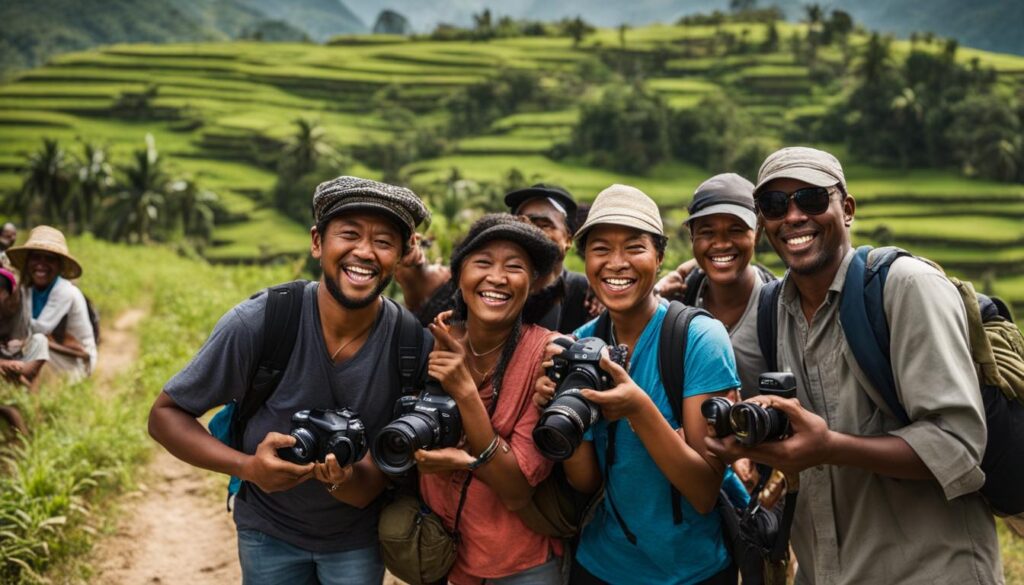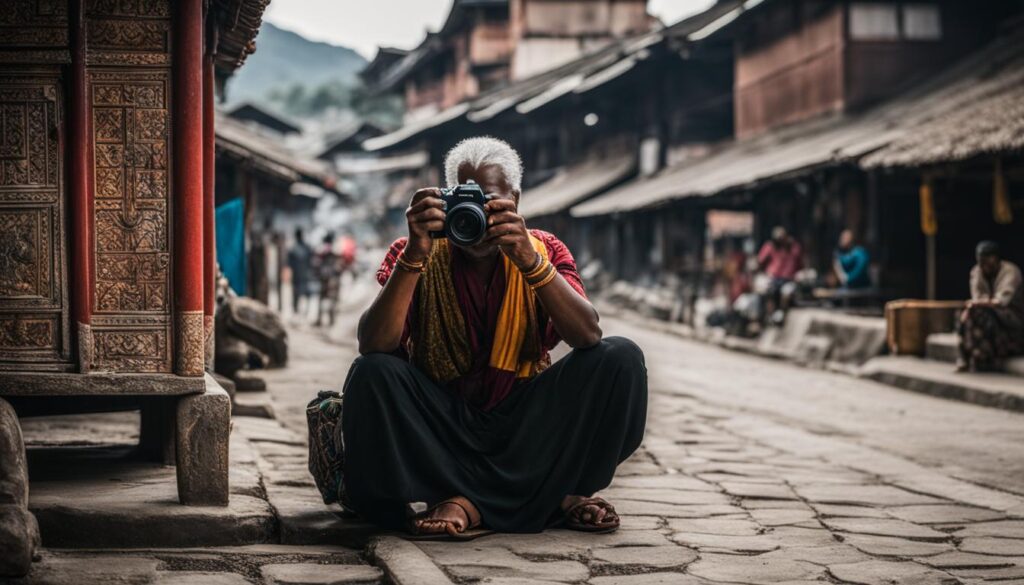Are you a travel photographer in pursuit of capturing meaningful moments while respecting cultures and environments? Look no further! This article provides an overview of tips and techniques for ethical travel photography. The practice of ethical travel photography entails being mindful of the impact your images can have on the communities and environments you visit. To ensure that your photography embodies ethical standards, it’s essential to do thorough research and prepare yourself before the trip.
In the following sections, you will learn about building meaningful connections with the locals, respecting privacy and obtaining consent, preserving cultural heritage, minimizing your environmental footprint, supporting local communities and sharing your photographs responsibly. But first, we will explore why ethical travel photography matters and the benefits that arise from being a responsible travel photographer. Join us on this journey towards ethical and mindful travel photography!
Why Ethical Travel Photography Matters
As a responsible traveler, your photography should be about more than capturing a beautiful image. Ethical travel photography is important because it considers the impact that our images can have on the people and places we visit. By promoting responsible travel photography, we can ensure that we leave a positive impact on the environment and the communities we encounter.
Responsible travel photography means being mindful of the impact our images can have and taking steps to minimize any potential harm. Conscious travel photography requires an awareness of the cultural nuances and sensitivities of the places we visit. Ethical photography tips help us to promote respect, dignity, and meaningful connections with the people and environments we encounter.
| Responsible Travel Photography | Conscious Travel Photography | Ethical Photography Tips |
|---|---|---|
| – Consider environmental impact | – Be mindful of cultural nuances and sensitivities | – Build meaningful connections with people and environments |
| – Avoid harmful practices | – Understand local customs and traditions | – Respect privacy and obtain consent |
| – Capture images that promote environmental awareness and conservation | – Preserve cultural heritage sites and sacred places | – Share responsibly and mindfully |
| – Support local communities and economies through photography | – Empower local artisans, businesses, and organizations | – Consider the impact our images can have on the community |
By promoting responsible travel photography, you can create beautiful images while also making a positive impact on the world around you. The key is to be mindful of the communities and environments you visit, and to use your photography as a force for good.
Research and Preparation
Embarking on a photography trip without adequately preparing can lead to cultural insensitivity and environmental damage. Therefore, before you go, it is essential to conduct research and equip yourself with the right ethical travel photography guide. Here are some factors to consider during your preparation:
| Factor | Considerations |
|---|---|
| Local Customs and Traditions | Learn about the culture and traditions of the destination you will visit. Understand what is considered offensive or inappropriate in that culture and learn basic phrases in the local language. |
| Environmental Concerns | Be aware of the environmental challenges of the destination. Avoid visiting fragile ecosystems and adhere to eco-friendly practices, such as minimizing waste and disposing of it properly. |
| Sensitivities | Before photographing people, be mindful of their sensitivities towards photography. Ask permission before taking photos, and respect their decisions if they refuse to have their picture taken. |
By researching and preparing adequately, your travel photography will be more responsible, respectful, and impactful. Additionally, you’ll have greater insight into the destination, enabling you to take more meaningful photos that highlight the people and environments accurately.
Building Meaningful Connections
One of the essential ethical travel photography techniques is building meaningful connections with the people you photograph. By connecting with the locals and understanding their culture, you can capture genuine moments and preserve their dignity. Here are some tips to help you do so:
Be Respectful
When approaching someone to take their photo, be polite and respectful. Always ask for their permission, and respect their decision if they decline. Remember, not everyone wants to be photographed, and it’s important to honor their privacy.
Show Genuine Interest
Show genuine interest in the people you photograph by striking up a conversation. Ask them about their life and culture, and listen to what they have to say. This will make them feel more comfortable and more likely to open up to you.
Learn a Few Phrases in the Local Language
Learning a few phrases in the local language can go a long way in building connections. Not only will it make it easier to communicate, but it also shows that you respect their culture and are making an effort to learn about it.
“Taking a photo is like giving a piece of your soul away. You allow other people to see the world through your eyes.” – Eddy Hagen
Avoid Stereotypes
Avoid reinforcing stereotypes and misrepresenting the culture of the people you photograph. Take the time to learn about their traditions and customs and represent them truthfully in your images.
Show Gratitude
Showing gratitude to the people you photograph is essential. Thank them for allowing you to take their picture and be sure to follow up on any promises you made. For example, if you promised to send them a copy of the image, make sure you do so.
Respecting Privacy and Consent
When capturing images of people during your travels, it’s essential to respect their privacy and obtain consent. Cultural differences can influence perceptions of privacy and appropriate behavior in different parts of the world, so it’s important to navigate these differences sensitively. Failure to do so can harm the people you photograph and their communities.
To ensure that your photography is ethical, you should seek permission from your subjects before taking their picture. Explain why you want to take the photograph, and allow them to decide whether they want to participate. If they decline, accept their decision graciously and move on.
To navigate cultural differences, approach people with sensitivity and observe the norms of the community you’re in. Be respectful of local customs and traditions, and seek guidance from locals if you’re unsure about appropriate behavior. Ultimately, your goal is to create meaningful images that capture genuine moments while preserving the dignity of the people you photograph.
“Photography is the power of observation, not the application of technology.” – Prerna Sharma
To summarize, obtaining consent and respecting privacy are essential aspects of ethical travel photography. Be sure to seek permission from your subjects, observe cultural norms, and approach people with sensitivity and respect. By doing so, you can capture meaningful images that preserve the dignity of the people you encounter during your travels.
Preserving Cultural Heritage
Cultural heritage sites, monuments, and sacred places are essential parts of the cultural identity and history of a destination. As a responsible travel photographer, it’s vital to preserve and respect these sites while capturing meaningful images that celebrate their significance. Here are some ethical travel photography techniques to help you preserve cultural heritage:
- Research the site’s history and significance to understand its cultural value.
- Respect cultural practices and customs by dressing appropriately, avoiding disruptive behavior, and showing reverence in religious sites.
- Seek permission from local authorities and communities before taking photographs.
- Use natural lighting to capture the essence of the site without disturbing its surroundings.
- Show reverence by avoiding damaging or manipulating the site, plants, or wildlife for a better shot.
By preserving cultural heritage, we can promote ethical travel photography that respects and honors the cultural identity of the destination.
Environmental Considerations
During your travels, it’s essential to be aware of your environmental impact and take steps to minimize it. Eco-friendly travel photography is all about capturing stunning images while respecting the natural environment. Here are some tips to help you do just that:
Leave No Trace
Whether you’re hiking through the mountains or exploring a coastal area, it’s important to leave the environment just as you found it. Avoid littering, stay on designated paths, and be mindful of any fragile plants or wildlife. By leaving no trace, you’ll help preserve the natural beauty of the destination for future generations.
Capture Images That Inspire Conservation
As a travel photographer, you have the power to inspire others to care about the environment. Consider capturing images that showcase the beauty of nature, such as breathtaking landscapes, colorful wildlife, or delicate flowers. These images can encourage others to get involved in conservation efforts and protect the planet.
Avoid Harmful Practices
Some photography practices can be harmful to the environment, such as disturbing wildlife or trampling vegetation. Be mindful of your surroundings and avoid any actions that could have a negative impact on the environment.
“The ultimate test of man’s conscience may be his willingness to sacrifice something today for future generations whose words of thanks will not be heard.” – Gaylord Nelson
Consider Your Mode of Transportation
Choosing eco-friendly transportation options, like bicycles or public transportation, can help reduce your carbon footprint while traveling. This not only benefits the environment but also provides unique opportunities for capturing photographs from a different perspective.
Supporting Local Communities
When practicing ethical travel photography, it is important to consider the impact our images can have on local communities. By supporting local artisans, businesses, and organizations, we can use our photography to make a positive difference.
One way to support local communities is to purchase goods directly from local vendors, rather than buying mass-produced souvenirs. This helps to support the local economy and preserve local traditions.
You can also use your travel photography to promote local organizations and causes. This can be done by featuring local nonprofits or highlighting a specific initiative or event that is important to the community.
“Photography is a way of feeling, of touching, of loving. What you have caught on film is captured forever… It remembers little things, long after you have forgotten everything.”
Additionally, you can work with local communities to ensure that your photography is respectful and highlights their unique culture. By building relationships and understanding their customs and values, you can create images that accurately represent their community and help to break down cultural barriers.
Remember that ethical travel photography is not just about capturing beautiful images – it’s about creating a positive impact on the places and people we encounter during our travels.
Sharing Responsibly
As a mindful travel photographer, it’s important to share your photos responsibly and with care. Before posting, consider the impact your images may have on the destination and its communities.
First, give credit where credit is due. If you’ve received inspiration from another photographer or website, make sure to acknowledge them in your caption or tags. This not only shows respect but also helps build a network of supportive creatives.
Second, avoid perpetuating stereotypes or harmful narratives about the places you visit. The media often portrays certain destinations, cultures, or peoples in a negative light, which can be damaging, unfair, and perpetuate ignorance. Be mindful of the language you use in your captions and try to share an accurate and respectful representation of the destination.
Finally, foster a positive narrative with your travel photography. Showcase the beauty, diversity, and uniqueness of the places you visit and encourage others to explore and appreciate the world we share. Along with your images, include information that will lead your followers to have a more meaningful experience and create a positive impact on their trips.
Conclusion
Congratulations! You have learned about the importance of ethical travel photography and the various tips and techniques that can help you capture meaningful images while promoting responsible and conscious practices. By incorporating these principles into your photography, you can create a positive impact on the communities and environments you encounter during your travels.
Remember, ethical travel photography is about respecting cultures and environments, building meaningful connections, obtaining consent, preserving cultural heritage, minimizing our environmental footprint, supporting local communities, and sharing our images responsibly and mindfully. By following these guidelines, you can capture images that tell authentic stories and foster a deeper understanding of the world around us.
Thank you for reading this article on ethical travel photography. We hope you found it informative and helpful in your future travels. Happy shooting!















































